|
Have a safe day!
Thursday, June 28
2:30 p.m.
Theoretical Physics Seminar - Curia II
Speaker: Takemichi Okui, Florida State University
Title: Gyroscopic Inflation
3:30 p.m.
DIRECTOR'S COFFEE BREAK -
2nd Flr X-Over
THERE WILL BE NO ACCELERATOR PHYSICS AND TECHNOLOGY SEMINAR TODAY
Friday, June 29
2 p.m.
Accelerator Controls Seminar - One West
Speaker: Jim Patrick, Fermilab
Title: Control System Application Development in Java
3:30 p.m.
DIRECTOR'S COFFEE BREAK - 2nd Flr X-Over
THERE WILL BE NO JOINT EXPERIMENTAL-THEORETICAL PHYSICS SEMINAR THIS WEEK
Click here for NALCAL,
a weekly calendar with links to additional information.
Upcoming conferences |
| Thursday, June 28
- Breakfast: Apple sticks
- Tomato Florentine
- Barbecue pork sandwich
- Smart cuisine: Kielbasa & sauerkraut
- Smart cuisine: chicken marsala
- Smoked turkey melt
- Assorted sliced pizza
- Southwest chicken salad w/ roasted-corn salsa
Wilson Hall Cafe Menu |
|
Friday, June 29
Dinner
- Warm fennel salad
- Lobster tail w/ lemon butter sauce
- Spaghetti squash w/ scallions
- Grilled asparagus
- Blueberry tartlets w/ lime curd
Wednesday, July 4
Lunch
Closed
Chez Leon Menu
Call x3524 to make your reservation.
|
|
Next week is Higgs week
Next week, scientists at the Large Hadron Collider and the Tevatron will announce their latest Higgs search results. Fermilab will host a number of events to share and explain the results, for both scientific and non-scientific audiences. Mark your calendars:
- Monday, July 2, 9 a.m., Ramsey Auditorium: Scientists from the Tevatron's CDF and DZero experiments present Tevatron Higgs search results in an hour-long scientific seminar. The seminar will be streamed live.
- Wednesday, July 4, 2 a.m., One West: Video of CERN's scientific Higgs seminar and the follow-up press conference is screened live via a dedicated connection for Fermilab employees, users, friends and family. Pajamas optional. CERN also offers a public webcast.
- Thursday, July 5, 9 a.m., Ramsey Auditorium: Stumped by a Higgs question from your neighbor? Want to know how Fermilab is involved in the search? This is your chance to get answers. COO Bruce Chrisman hosts a 30-minute all-hands meeting to provide employees with a short, non-technical summary of the Higgs results and what they mean.
- Friday, July 6, 4 p.m., One West: US LHC scientists present more details on the LHC Higgs results in a scientific seminar.
Fermilab Today will provide more information on each event in the upcoming days.
|
The unreasonable Tevatron: Calculating the economic impact of basic science
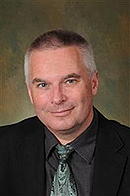 |
| STFC Chief Executive Officer John Womersley discussed the Tevatron's economic impact at the June 11 Tevatron symposium. Photo: STFC |
During a recent symposium at Fermilab, a speaker took the stage to defend government investment in basic science. He used an odd tactic: He called particle physics unreasonable.
John Womersley, chief executive officer of Britain's Science and Technology Facilities Council, was referring to a saying by the eminently quotable George Bernard Shaw. Shaw said that a reasonable man adapts to society, but an unreasonable man insists that society adapt to him. Therefore, Shaw argued, all progress depends on unreasonable people.
"Particle physics is unreasonable," Womersley said at the June 11 symposium celebrating the now-retired Tevatron particle accelerator. "It makes unreasonable demands on technology."
But scientists are persistent, he said; when they don't have the things they need to conduct an experiment, they take it upon themselves to create them.
"And when those technologies, those inventions, those innovations happen," Womersley said, "they spread out into the economy, and they generate a huge impact."
Read more
|
GEM provides paths to advanced STEM degrees
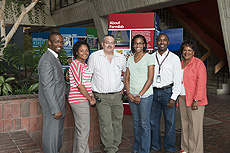 |
| Dr. Marcus Huggans from the National GEM Consortium and Dianne Engram with former and current GEM interns. From left: Marcus Huggans, Elmie Peoples, Miguel Nuñez, Bianca Brandveen, Maurice Ball and Dianne Engram. Photo: Reidar Hahn |
Since the late 1970s, the National GEM Consortium has provided opportunities for African American, Hispanic and Native American graduate students seeking non-academic careers in science and engineering. Fermilab has been a part of these efforts almost since the beginning.
The Consortium is a partnership among more than 50 American companies and national laboratories and 100 universities to promote graduate degrees among these demographic groups, which have historically been underrepresented in science, technology, engineering and mathematics fields.
"For Fermilab, the program is designed to provide a pipeline of candidates for full-time employment," said Dianne Engram, manager of Fermilab’s Equal Opportunity Office, who holds a position on GEM's executive committee.
Through GEM fellowships, participating universities pay the full tuition for a graduate degree and companies select the fellows as interns. Throughout the consortium's history, more than 3,000 students have been named GEM fellows.
The internship gives companies such as Fermi Research Alliance an opportunity to assess the sponsored students and provide work experiences that enhance the student’s understanding of their chosen field. The students go through two such internships, one in the summer between their final undergraduate year and their first semester of graduate school and another after the first year of graduate school.
"Without the GEM program I wouldn't be in grad school right now – I couldn’t afford it otherwise," said Bianca Brandveen, Fermilab's current GEM fellow, who is getting her master's degree in mechanical engineering at the University of Maryland - College Park. "GEM is an invaluable resource for minority students who want to pursue graduate degrees in STEM fields." Brandveen is currently in her second internship at Fermilab.
Brandveen, who will present her work at Fermilab at GEM's Annual Board Meeting and Conference in San Francisco in August, said it's also important for her to give back, so she has been participating in recruiting potential GEM fellows.
"It's not just something I want on my résumé," she said. "I truly enjoy giving back to people and teaching them what I learned when I was their age."
Fermilab currently employs four previous GEM fellows. A fifth is due to start next month, Engram said.
"We want boots-on-the-ground work," she said. "Our goal is to increase our number of master’s-trained professionals at Fermilab, and as long as the fellows are working in a STEM profession, the program is a success."
—Joseph Piergrossi
|
7 trillion degrees Fahrenheit: Atom-smashing physicists break temperature record
From the Christian Science Monitor, June 27, 2012
A giant atom-smashing racetrack of sorts has just broken a Guinness World Record by reaching the highest man-made temperature ever recorded, scientists announced Monday (June 25).
How hot? 250,000 times hotter than the center of the sun.
This scorching achievement happened inside the Relativistic Heavy Ion Collider (RHIC), which is a 2.4-mile (3.9 kilometers) underground track where particles smash into one another under conditions that existed about a millionth of a second after the Big Bang.
Read more
|
|
Pomeron creates jets at the Tevatron
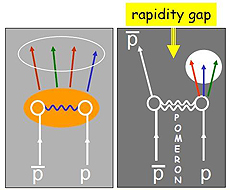 |
| Antiproton-proton scattering by the strong interactions
can be non-diffractive (left) or diffractive (right). Both original particles, the proton and antiproton, are colorless.
|
At the Fermilab Tevatron, protons and antiprotons were brought into collision at very high energies, equivalent to about 2,000 proton masses according to Einstein's equation, E=mc2. In each collision, about 100 particles of different types are produced.
A small group at CDF has been studying what scientists call the diffractive production of jets, in which "ghost" particles help create these sprays of highly collimated particles. Exactly how are they produced?
The proton and antiproton each consists of three quarks bound by the strong force. Though the proton and antiproton are free to move inside a "bag" full of gluons and quarks, the gluons and quarks themselves are confined to each other in order to maintain something called color-neutrality.
Diffractive collisions, in the simplest case, are characterized by an outgoing antiproton, a region in which there are no particles (called a rapidity gap) and a particle cluster corresponding to the initial proton. The particle cluster is shown as the white circle in the top figure.
This kind of collision can be explained by the color-neutral exchange of a particle called a pomeron. With its vacuum-like properties, a pomeron can escape invisibly out of the quark-gluon bag like a ghost, strike the passing proton and give it an energy injection by allowing itself to be absorbed by the proton. The energy is used to create jets that faithfully obey the equation E=mc2.
The results of this experiment can be explained by a model (called DL in the figure below) at low-momentum transfers (t) between the incoming and outgoing antiproton by way of the escaping pomeron. However, the model does not explain the result for high-momentum transfers, where the data is constant. It will be interesting to see how the theory can be adapted to the high-momentum data.
These measurements are being repeated at the higher energies of the LHC to provide more discrimination among theoretical models.
Learn more
—edited by Dino Goulianos and Andy Beretvas
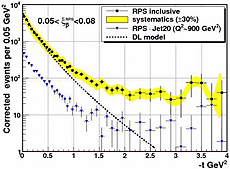 |
| A scintillator fiber tracker (RPS) is used to observe diffractive events as a function of the momentum transfer between the incoming and outgoing antiproton.
|
 |
| These physicists were responsible for this analysis.
From left: Michele Gallinaro, Dino Goulianos and Koji Terashi, all from Rockefeller University. |
|
Instrumentation Department picnic at Kuhn Barn
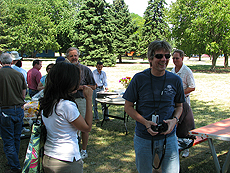 |
Members of the AD Instrumentation Department gathered for a picnic at Kuhn Barn on June 27, hosted by department head Manfred Wendt. Photo: Joseph Piergrossi |
|
DOE counterintelligence personnel visit Fermilab today
Members from the Department of Energy's Chicago Office of Counterintelligence will visit Fermilab today. They will set up a booth in the atrium of Wilson Hall to answer any employee questions.
This activity is part of the laboratory's Facility Counterintelligence Program. The program is required of all Department of Energy national laboratories.
The goals of Fermilab's program are:
- To protect Fermilab personnel, research, technologies and information and cyber systems from unauthorized exploitation by intelligence collectors and intelligence activities.
- To participate, as appropriate, in the national DOE effort to protect DOE personnel, projects, information/cyber systems and classified materials from unauthorized collection or exploitation by foreign intelligence practitioners.
Since Fermilab is a single-purpose research laboratory whose mission does not include classified research, the program excludes many comprehensive procedures required at other DOE laboratories.
Employees should receive the laboratory's annual counterintelligence briefing via interoffice mail later today.
|
|